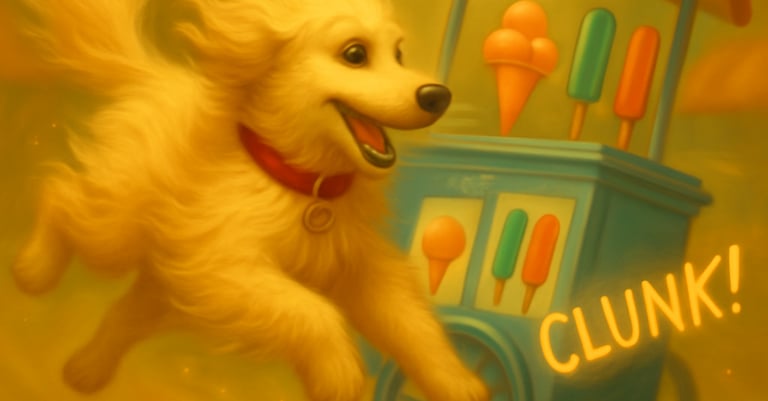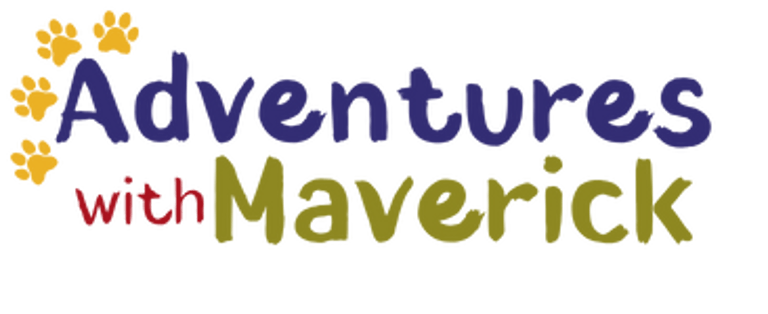The Magic of Sound Effects in Children's Books
From Maverick's signature 'SNIFF-SNIFF-SNORT!' to the 'WHOOSH!' of his wagging tail, discover how sound effects make reading more engaging and help children connect with stories
PARENT RESOURCESREADING TIPS
Heather George
7/20/202512 min read


When I first started writing "Adventures with Maverick: The Curious Pup," I knew that capturing the essence of my real dog Maverick would require more than just describing what he looked like or what he did. I needed to bring readers into his world through all their senses, and that meant finding a way to translate the symphony of sounds that make up daily life with a curious, energetic pup into words on a page.
The decision to fill Maverick's story with sound effects—from his enthusiastic morning "YAWN!" to his investigative "SNIFF-SNIFF-SNORT!" to the rhythmic "THUMP-THUMP!" of his happy tail—wasn't just about making the story more fun to read aloud. It was about recognizing that children experience the world through sound just as much as they do through sight, and that the most memorable and engaging stories are those that activate multiple senses and invite young readers to participate actively in the storytelling experience.
Sound effects in children's literature serve as bridges between the written word and the lived experience, transforming passive reading into active participation and helping children develop crucial literacy skills while having fun. They're not just decorative elements or cute additions—they're powerful tools that can enhance comprehension, build phonemic awareness, support emotional connection, and create the kind of joyful reading experiences that turn children into lifelong book lovers.
The Science Behind Sound and Learning
Understanding why sound effects work so well in children's books requires looking at how young minds process and retain information. Children are naturally drawn to sounds—from the earliest age, they respond to the rhythm and melody of language, the comfort of familiar voices, and the excitement of new and interesting noises. This attraction to sound isn't just preference; it's how their brains are wired to learn.
When children hear sound effects while reading, multiple areas of their brain are activated simultaneously. The auditory processing centers work to decode and understand the sounds, while the language centers connect those sounds to meaning and context. The memory centers store not just the words and their meanings, but the sensory experience of hearing them. This multi-sensory approach to learning creates stronger, more durable memories and deeper understanding.
The rhythmic nature of many sound effects also taps into children's natural love of pattern and repetition. When Maverick goes "SNIFF-SNIFF-SNORT!" the three-part pattern creates a satisfying rhythm that children can anticipate and join in with. This predictability helps build confidence in emerging readers while the variation in the final sound keeps the pattern interesting and engaging.
Sound effects also support phonemic awareness—the ability to hear and manipulate individual sounds in words—which is a crucial foundation for reading success. When children hear and repeat sounds like "WHOOSH!" or "THUMP-THUMP!" they're practicing the kind of sound discrimination and production that will serve them well as they learn to decode written words.
The emotional impact of sound effects cannot be understated either. Sounds carry emotional weight and can instantly convey mood, excitement, comfort, or surprise. When Maverick's tail goes "WHOOSH!" as it wags so fast it looks like a blurry fan, children don't just understand that he's happy—they feel his excitement and joy. This emotional connection helps children invest in the story and care about what happens to the characters.
Creating Character Through Sound
One of the most powerful aspects of sound effects in children's literature is their ability to create and reinforce character traits. Maverick's signature sounds aren't random choices—each one reflects something important about his personality and helps children understand who he is as a character.
The "SNIFF-SNIFF-SNORT!" that appears throughout the story perfectly captures Maverick's curious nature. It's not just one sniff—it's a thorough investigation that shows his methodical approach to exploring the world around him. The final "SNORT!" adds a touch of enthusiasm and perhaps a bit of the mess that comes with being a curious pup. When children hear this sound effect, they immediately understand that Maverick is the kind of dog who doesn't just notice interesting smells—he investigates them completely.
His morning "YAWN!" followed by his ready-for-adventure attitude shows the transition from sleepy pup to energetic explorer. The sound effect helps children understand that Maverick doesn't just wake up—he wakes up with purpose and excitement. This sets the tone for his character and helps children anticipate the kind of day he's going to have.
The "THUMP-THUMP!" of his tail wagging creates a rhythm that mirrors the beat of a happy heart. It's not just a description of movement—it's a sound that conveys pure joy and contentment. When children hear this sound effect, they can almost feel the vibration of Maverick's happiness, creating an immediate emotional connection.
Even Maverick's mischievous "Hee-hee!" when he's caught with his sock collection reveals something important about his character. It's not a sound of guilt or shame—it's the sound of a pup who finds joy in his own cleverness and doesn't take himself too seriously. This sound effect helps children understand that Maverick's mischief comes from a place of playfulness rather than naughtiness.
These character-defining sound effects help children develop a deeper understanding of Maverick as a fully realized character rather than just a cute dog in a story. They learn to "read" personality through sound, a skill that will serve them well as they encounter more complex characters in future reading.
Building Engagement Through Participation
Sound effects transform reading from a solitary activity into a participatory experience. When children encounter Maverick's "SNIFF-SNIFF-SNORT!" they don't just read the words—they want to make the sounds themselves. This natural inclination to participate is one of the most valuable aspects of including sound effects in children's books.
The act of making sounds while reading engages children's bodies as well as their minds. They're not just sitting passively while someone reads to them—they're actively contributing to the storytelling experience. This physical engagement helps kinesthetic learners, who process information best through movement and touch, connect more deeply with the story.
Participation through sound effects also builds confidence in reluctant readers. Children who might feel intimidated by complex words or long sentences can successfully contribute to the reading experience by making sound effects. This success builds their confidence and helps them see themselves as capable participants in the reading process.
The interactive nature of sound effects also makes reading more social and collaborative. When families read together, sound effects become opportunities for shared fun and connection. Parents and children can take turns making different sounds, create their own interpretations of the effects, or even develop family traditions around how certain sounds should be made.
This collaborative aspect extends beyond the immediate reading experience. Children often continue making the sound effects long after the book is closed, incorporating them into their play and daily activities. When a child goes "SNIFF-SNIFF-SNORT!" while exploring the backyard or makes "THUMP-THUMP!" sounds while playing with toy dogs, they're extending the story experience and making it part of their own world.
Supporting Language Development
Sound effects in children's books serve as powerful tools for language development, supporting everything from vocabulary growth to understanding of rhythm and rhyme. Each sound effect introduces children to new ways of representing experiences through language and helps them understand that words can capture not just objects and actions, but sensations and emotions as well.
The onomatopoeia used in sound effects—words that imitate the sounds they represent—helps children understand the relationship between sounds and symbols. When they see "WHOOSH!" on the page and hear the corresponding sound, they're learning that written symbols can represent auditory experiences. This understanding is crucial for developing reading comprehension and will help them decode unfamiliar words throughout their reading journey.
Sound effects also introduce children to the concept that language can be playful and creative. The exaggerated nature of written sound effects—with their capital letters, exclamation points, and creative spelling—shows children that language doesn't always have to follow standard rules. This understanding can free them to experiment with language in their own writing and speaking.
The rhythmic patterns found in many sound effects support children's understanding of prosody—the rhythm, stress, and intonation of language. When children learn to say "SNIFF-SNIFF-SNORT!" with the right rhythm and emphasis, they're developing skills that will help them read with expression and understand the musical qualities of language.
Sound effects also expand children's vocabulary in unique ways. While they might not encounter words like "WHOOSH!" or "THUMP-THUMP!" in everyday conversation, these words give them language for describing experiences and sensations they recognize. This expanded vocabulary helps them become more precise and creative in their own communication.
Creating Emotional Connections
Perhaps one of the most important functions of sound effects in children's books is their ability to create immediate emotional connections between readers and characters. Sounds carry emotional weight in ways that pure description sometimes cannot, and they can instantly convey mood, atmosphere, and feeling.
When Maverick makes his contented sighs or happy tail-thumping sounds, children don't just understand that he's happy—they feel his happiness. The sound effects create an emotional bridge that helps children empathize with the character and invest in his experiences. This emotional connection is crucial for developing reading comprehension, as children who care about characters are more likely to pay attention to what happens to them and remember the details of their stories.
Sound effects also help children process and understand their own emotions by giving them language for experiences they recognize. A child who has felt the excitement of discovering something new can relate to Maverick's enthusiastic investigation sounds. A child who has experienced the comfort of a favorite toy can connect with the gentle sounds associated with Maverick and his beloved Pups.
The emotional impact of sound effects extends beyond individual moments in the story. The consistent use of certain sounds helps create emotional themes and patterns that children can follow throughout the book. Maverick's happy sounds become associated with positive experiences, while different sounds might signal challenges or changes in mood.
This emotional scaffolding helps children develop emotional intelligence and empathy. As they learn to "read" the emotional content of sound effects, they're also learning to recognize and interpret emotional cues in real life. The skills they develop in understanding how Maverick's sounds reflect his feelings can transfer to understanding how tone of voice, laughter, or sighs might reflect the emotions of people around them.
Enhancing Memory and Recall
Sound effects serve as powerful memory aids that help children remember and retell stories. The distinctive nature of sounds makes them particularly memorable, and children often recall sound effects long after they've forgotten other details of a story. This memorability serves multiple important functions in literacy development.
When children can remember sound effects, they have anchor points that help them recall the sequence of events in a story. The progression from Maverick's morning "YAWN!" to his investigative "SNIFF-SNIFF-SNORT!" to his happy "THUMP-THUMP!" creates a sound-based timeline that children can follow and remember. This sequential memory supports comprehension and helps children understand narrative structure.
The memorable nature of sound effects also supports retelling, which is a crucial skill for reading development. When children retell stories, they're practicing narrative structure, sequencing, and vocabulary. Sound effects give them concrete, memorable elements to include in their retellings, making the task more manageable and enjoyable.
Sound effects also create what educators call "hooks" for memory—distinctive elements that help children access stored information. When a child hears "SNIFF-SNIFF-SNORT!" weeks after reading the story, they're likely to remember not just that sound, but the context in which it occurred, the character who made it, and the events that surrounded it. This kind of associative memory is powerful and supports long-term retention of story content.
The rhythmic and patterned nature of many sound effects also taps into children's natural ability to remember songs, chants, and rhymes. Just as children can remember the words to songs they've heard only a few times, they can remember sound effects and their contexts with remarkable accuracy. This musical quality of sound effects makes them particularly effective memory tools.
Practical Tips for Parents and Educators
Understanding the power of sound effects is one thing; knowing how to use them effectively during reading time is another. The key to maximizing the benefits of sound effects lies in approaching them with enthusiasm, consistency, and creativity while remaining sensitive to each child's comfort level and learning style.
When reading aloud, embrace the sound effects fully. Don't be shy about making Maverick's "SNIFF-SNIFF-SNORT!" with gusto or creating the "WHOOSH!" of his wagging tail with appropriate drama. Your enthusiasm will be contagious and will signal to children that these sounds are important and fun parts of the story. Remember that your willingness to be playful and expressive gives children permission to do the same.
Consistency in how you produce sound effects helps children learn to anticipate and participate. If you make Maverick's tail-wagging sound a certain way the first time, try to maintain that interpretation throughout the story and across multiple readings. This consistency helps children feel confident in joining in and creates a sense of familiarity that enhances their comfort with the story.
Don't be afraid to pause and let children contribute their own interpretations of sound effects. If a child wants to try their version of "THUMP-THUMP!" or has their own idea about how Maverick's "Hee-hee!" should sound, encourage this participation. These moments of creative contribution help children feel ownership over the story and build their confidence as active participants in the reading process.
Use sound effects as opportunities to extend the story beyond the book. Encourage children to notice and name sounds in their own environment, connecting them to the sounds they've encountered in Maverick's story. When you hear a dog sniffing during a walk, you might say, "That sounds like Maverick's 'SNIFF-SNIFF-SNORT!'" These connections help children understand that the language and experiences in books relate to their real world.
Consider creating actions or gestures to accompany sound effects. When Maverick's tail goes "THUMP-THUMP!" you might pat your leg to create the rhythm. When he does his big morning stretch and "YAWN!" you might stretch your own arms wide. These physical accompaniments help kinesthetic learners engage with the story and create additional memory anchors for all children.
The Broader Impact on Literacy Development
The benefits of sound effects in children's books extend far beyond the immediate enjoyment they provide. These seemingly simple additions to text support multiple aspects of literacy development and help create the foundation for advanced reading skills.
Sound effects support phonological awareness by helping children tune into the sounds of language. When children play with the sounds in "SNIFF-SNIFF-SNORT!" they're practicing the kind of sound manipulation that will help them understand how letters combine to make words. This playful approach to sounds makes phonics instruction more engaging and meaningful.
The dramatic, expressive reading that sound effects encourage helps children understand that reading should be meaningful and expressive. When children learn to read Maverick's sounds with appropriate emotion and emphasis, they're developing the prosody skills that will help them read all texts with better comprehension and expression.
Sound effects also support the development of inferential thinking skills. When children hear the "WHOOSH!" of Maverick's tail, they must infer that he's very happy or excited. When they hear his investigative "SNIFF-SNIFF-SNORT!" they must infer that he's found something interesting to explore. This practice in making inferences from textual clues is crucial for reading comprehension.
The participatory nature of sound effects helps children develop the understanding that reading is an active process. Rather than passively receiving information, children learn that they can and should engage with texts, bringing their own voices, interpretations, and creativity to the reading experience. This active approach to reading serves them well as they encounter more complex texts that require critical thinking and analysis.
Creating Your Own Sound Effect Magic
While "Adventures with Maverick" provides a wonderful example of how sound effects can enhance children's books, the principles behind their effectiveness can be applied to any reading experience. Parents and educators can create their own sound effect magic with any book by being creative and responsive to the stories they're sharing.
Look for opportunities to add sound effects to books that don't already include them. If you're reading about a car, add a "VROOM!" If there's a door in the story, create a "CREAK!" when it opens. If characters are walking, add footstep sounds. These additions help bring stories to life and create the same kind of engagement that built-in sound effects provide.
Pay attention to the sounds that are implied but not explicitly written in stories. The wind through trees might become a gentle "WHOOSH!" The bubbling of a stream might become a cheerful "GURGLE-GURGLE!" A character's laughter might become a specific "HEE-HEE-HEE!" These interpretive additions help children understand that stories contain more sensory information than what's explicitly stated on the page.
Encourage children to create their own sound effects for stories. Ask them what sound they think a particular character might make, or how they would represent a specific action through sound. This creative participation helps children develop their own relationship with language and storytelling.
Remember that the goal isn't perfection—it's engagement and joy. Your sound effects don't need to be realistic or sophisticated. They just need to be enthusiastic and consistent. Children are remarkably forgiving of imperfect sound effects, and they're much more interested in your willingness to play and participate than in your technical accuracy.
The magic of sound effects in children's books lies not in their complexity, but in their ability to transform reading from a solitary, silent activity into a shared, joyful, multisensory experience. When we embrace the "SNIFF-SNIFF-SNORT!" and "WHOOSH!" and "THUMP-THUMP!" of stories like Maverick's, we're not just making reading more fun—we're supporting language development, building emotional connections, enhancing memory, and creating the kind of positive associations with books that last a lifetime.
Every time a child joins in with Maverick's enthusiastic sounds, they're learning that reading is participatory, that language is playful, and that books are sources of joy and connection. These lessons, learned through the simple magic of sound effects, become the foundation for a lifelong love of reading and a deep appreciation for the power of stories to bring us together.
"Adventures with Maverick: The Curious Pup" is available now. Embrace the sound effects and discover how these simple additions can transform your reading experience and help children develop crucial literacy skills while having fun.
Shop Maverick's Favorite Things


Snuggle Puppy
Maverick's security toy since he was a puppy!


Chuck It Ultra Ball
Maverick's favorite orange balls!
Get in touch


